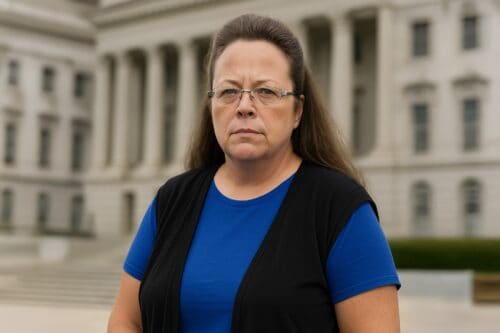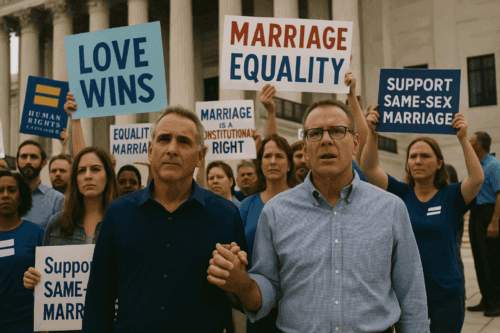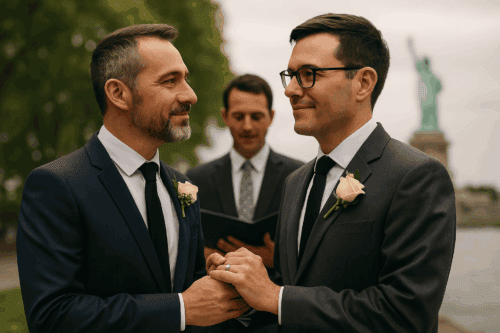
Marriage Equality on Life Support?
Ten years after the Obergefell ruling, I didn’t think we’d be back here. And yet—this summer—Kim Davis, the Kentucky clerk who once refused licenses to same sex couples, asked the Supreme Court to toss the Obergefell decision. Wild, right? Not just a headline. A legal gambit. If the Supreme Court even signals interest, opponents in many states will sprint to pass new laws or revive old bans and tell same sex couples, “Sorry, not here.” It’s enough to make you wonder: Is Marriage Equality on Life Support?
Short answer: could they really undo it? I hate saying this, but yes, if the Supreme Court chooses to. We learned from Dobbs that precedent can melt in a single opinion. The danger isn’t abstract. If Obergefell falls, a county clerk in your given state might stop issuing licenses the next morning, and your relationship status could become a question mark. Meanwhile, the Respect for Marriage Act means other states must still recognize marriages performed elsewhere, and the federal government would keep recognizing them—so you could fly to another state, marry, then come home. But equality you have to travel for isn’t full equality. It’s a scavenger hunt.
Here’s the part most people miss: this isn’t only about law—it’s about health, safety, and day-to-day well being. Legal security reduces stress. Stress affects bodies. Bodies get sick. Threats to marriage equality ripple through families, clinics, hospitals, and insurance plans. It’s not politics for sport. It’s public health.
From DOMA to Obergefell: A Long Fight for Love
Rewind to 1996. That year, Congress passed the Defense of Marriage Act. DOMA not only defined marriage at the federal level as one man and one woman, but also blocked benefits for same sex spouses. In the years that followed, many states quickly joined in, pushing constitutional amendment campaigns that defined marriage narrowly and shut doors to legal protections. However, by the late 1990s, reform efforts had already started popping up—advocates were organizing, filing lawsuits, and persuading legislators. As a result, the ground was beginning to shift under everyone’s feet.
Fast forward to 2003. The landmark Lawrence v. Texas decision swept away the remaining sodomy laws, marking a major turning point. In Massachusetts, the state’s high court went even further, ruling that denying legal marriage to same sex partners violated equality. Consequently, Massachusetts became the first state to issue licenses in 2004, and something cracked open in the country’s imagination. In the years that followed, many states experimented with halfway steps—civil unions and domestic partnerships. They sounded generous at first glance; however, in practice, they were confusing. For example, a couple might have hospital visitation rights in one city and lose them just two counties over. Meanwhile, other states ignored their paperwork entirely.

Legal Victories and Nationwide Marriage Equality
Two 2013 Supreme Court cases changed the air pressure. United States v. Windsor forced the federal government to recognize marriages sanctioned by a state. Hollingsworth v. Perry swatted down California’s Prop 8 path and brought marriages back to the nation’s most populous state. Momentum built; relationships moved from private to fully public. By early 2015, courts and legislatures in dozens of jurisdictions had created avenues to marry; a few holdouts still clung to bans. Then came June 26, 2015. The Obergefell decision declared marriage a fundamental right for same sex couples. Overnight, marriage rights extended nationwide.
We celebrated and cried. We called our parents, who finally recognized our partner as family. And, yes, society adjusted far faster than doomsayers predicted. In 2022, Congress repealed DOMA and passed the Marriage Act, guaranteeing recognition across the country. But recognition is not the same as easy access. If a state stops issuing licenses, couples must fly out, book a hotel, spend money, and hope HR back home reads the law right. That’s not equality; that’s bureaucracy with a smile.
Love and Health: Why Marriage Equality Saves Lives
Let’s talk about the part that rarely gets headlines: health. Not just “feelings,” but measurable outcomes. Marriage equality has had a profound positive effect on the security and well being of LGBTQ+ people. When same-sex couples gain legal marriage, their self-reported health improves. When they lose rights, stress spikes. It’s not mysticism; it’s biology.
Start with the obvious: two people sharing life tend to share care. Married people—heterosexual couples and same sex couples alike—live longer, report better overall health, and navigate crises with a built-in teammate. A spouse reminds you to take your medicine, nudges you to make that appointment, and sits next to you when the doctor starts listing scary health conditions. The emotional and social support inside a marriage reduces stress, which supports immune and cardiovascular functioning. Less cortisol. Lower blood pressure. Fewer 3 a.m. panic spirals. I mean, it’s not magic, but it looks a lot like science.
There’s also the boring but decisive stuff: health insurance and health care logistics. Before nationwide marriage equality, many employers refused spousal coverage for same sex partners. After the Supreme Court cleared the path, same sex spouses were added to family plans. That’s not a perk; it’s access—to specialists, to mental health services, to medication refills that keep a person alive. It’s the difference between catching something early and catching it too late.
Why Legal Recognition Matters for Well-Being
Zoom out. Studies comparing same sex couples in states with legal marriage to those in states with antigay amendments found higher levels of self-assessed health where marriage was sanctioned. Many married same sex couples report that marriage improved their sense of safety and security. That security shows up as less drinking to cope, fewer emergency visits, steadier sleep. University researchers have tracked exactly that—drops in stress-linked conditions after rights expand. Another university study tied legal recognition to increased life satisfaction among same sex couples. And if you want one more: a university team looking at insurance utilization found fewer gaps for couples who could add a spouse to coverage. Not shocking—just overdue.
Flip the coin. Same sex couples face elevated health risks tied to minority stress. Discrimination is a chronic stressor; your body doesn’t care that it’s legal—it fires the same stress chemistry. When the state tells you your ability to marry is conditional, your body hears: not safe. Over time, that’s corrosive. We’ve seen it in higher anxiety and depression when bans pass and in improvements when bans fall. No wonder public health experts argue that denying marriage equality is a public health hazard. Policy choices show up in clinic data, lab numbers, and funerals.
Legal Stability in Real Life
Let’s also name something tender. Legal stability keeps families intact in emergencies. A woman whose wife is suddenly hospitalized doesn’t have to beg a receptionist to be let in, a man managing a partner’s chemo doesn’t have to produce a stack of documents to prove his standing, and a transgender person in middle age caring for their aging spouse has the authority to sign forms without a courtroom detour. That quiet certainty lowers stress for everyone—partners, kids, adult children of queer parents, and the staff trying to do their job.
Last point in this section, and it’s blunt: civil unions weren’t enough. They sometimes offered partial legal protections, but the data on well being never matched legal marriage. Naming matters. Recognition matters. Dignity is not a frill; it’s a health intervention.

A Cruel Catch-22 for Disabled Couples
Now the painful truth: marriage equality isn’t finished until it includes people with disabilities. Right now, too many are boxed into a cruel paradox. If a disabled person marries, they can be penalized—losing benefits they rely on to live. That’s not a rumor; it’s how certain Social Security and Medicaid rules work.
Here’s the Catch-22. Under specific programs—especially the Disabled Adult category—marrying a nondisabled partner can terminate income and health care coverage, as if the new spouse is obligated to shoulder everything. Even when two disabled people marry, strict resource limits can slash support. Result: couples stay “roommates,” delay ceremonies, or keep separate addresses. It’s humiliating, and it’s not rare. Many individuals with disabilities depend on government programs for basic needs and assistance; the current setup created a world where love risks poverty.
The stigma behind it is old, ugly, and familiar: that disabled people don’t have the same desires for relationships as non-disabled people. A century ago, some states literally banned people with certain disabilities from marrying. Those statutes are gone, but the mindset lingers in policy. Today’s rules treat a disabled spouse as a “burden” to the partner, and the state washes its hands. That’s not neutrality—it’s discrimination with paperwork.
Why We Need to End the Marriage Penalty
It gets more concrete. Imagine a young woman on Medicaid personal-care services who marries her longtime partner. Overnight, the algorithm decides the household has “too much” because of the spouse’s income. Home aides disappear. Wheelchair repairs get delayed. She isn’t suddenly “more able” because she said vows; the rules simply changed. Another example: a man in late age on SSI who marries his boyfriend loses cash aid that covered rent. The money gap becomes medical debt, then eviction risk. He didn’t “game the system.” He got married.
The community is loud and clear: no penalties should take away the right to choose to marry. Activists, including many lesbians and gay men with disabilities, are pushing legislation—the Marriage Equality for Disabled Adults Act—to end the penalty so people aren’t unable to wed without losing lifelines. It’s common sense. If marriage equality is real, you shouldn’t have to pick between a ring and a home nurse, between vows and ventilator supplies. As advocates in Washington keep saying: your right to marry shouldn’t depend on your diagnosis or your job prospects.
Why the urgency? The unemployment rate among people with disabilities is staggeringly high—often cited as over 80% in some communities—amplified by bias and barriers. Expecting a spouse to plug the entire gap isn’t policy; it’s fantasy. We need law that reflects reality and human dignity. Until the penalty is gone and protections are guaranteed, we do not have full marriage equality—we have a promise with an asterisk.
Love’s Promise: Why We Can’t Take Marriage Equality for Granted
Here’s the thing about marriage in America: our law can lift you up or pull the rug out. We’ve watched society move from panic to acceptance in a generation. Public health data improved. Families stabilized. Same sex couples planned estates instead of escape routes. Lesbian couples adopted and raised kids with less red tape. Heterosexual couples mostly went on with their lives—because other people’s weddings never hurt their marriages. Most people know this. And yet the fight circles back.
Holding the Legal Line
What do we do now? We hold the line at the Supreme Court and in legislatures. Protect the Obergefell decision. Oppose efforts that pretend civil unions are “good enough.” Demand that any court nominee publicly commit to equal marriage under the Constitution. If opponents push a constitutional amendment to erase equality (unlikely, but not impossible), we organize faster than they do.
We widen the circle. Pass the Marriage Equality for Disabled Adults Act. Remove the penalty so people can marry without losing benefits. Fix agency guidance so HR departments don’t botch coverage. Ensure health insurance carriers treat legally married couples consistently. That’s not radical; that’s competence.
And we keep telling the truth about health. Marriage equality is not merely symbolic. It correlates with lower stress, fewer stress-linked health conditions, and stronger relationships. The ability to name a spouse on forms becomes a quiet emergency plan. Hospitals move faster. Pharmacies answer quicker. The ripple effects of access show up in lab results and long life. Take it away, and you don’t just bruise dignity—you hurt bodies.
The Power of the Vote
We vote up and down the ballot. Governors sign and veto. Attorneys general choose how to defend or undermine. County officials make daily calls that affect licenses and records. If we want secure marriage across the country, we need leaders who get it. That’s how law becomes lived reality.
Finally—and this part is personal—we keep loving out loud. Visibility helped win the first time. When lesbians, gay men, bi folks, trans folks, and people with disabilities introduced their families to neighbors and co-workers, opinions shifted. Over three decades, public support grew, one conversation at a time. It wasn’t magic; it was courage. It still is.

Marriage Equality on Life Support
Why Marriage Equality Matters
I’ll end where I began, with a gut check. If you’re reading this as a woman married to a woman, or a man married to a man, or anyone who has ever had to fight for their partner, you know marriage isn’t just romance. It’s paperwork, health care, taxes, leases, custody, immigration, and grief—the everyday grind of who gets the kids, who handles medicine, and who calls the plumber—ordinary and astonishing all at once. And for same sex couples, it was denied for too long. We have it now because people refused to quit, and courts finally caught up with reality.
So, no, I don’t believe the Supreme Court gets the last word on love. But I do believe we have to show up—again. If opponents take another run at marriage equality, we meet them in Washington, in statehouses, in school gyms, on courthouse steps. We protect what we’ve built and fix what’s broken, especially for people with disabilities still stuck behind the penalty. We fight like families do: fiercely, together.
Because in the end, marriage is not a culture-war trophy. It’s a public good. It stabilizes relationships, strengthens communities, and improves well being. It helps people live longer, better—yes, even if they’re cranky before coffee and forget to change the air filter. When we defend marriage equality, we’re defending health, dignity, and the simple human right to marry the person who makes your life livable.
Jack and Jill Adult proudly support equality in all its forms because love and dignity should never be up for debate.

